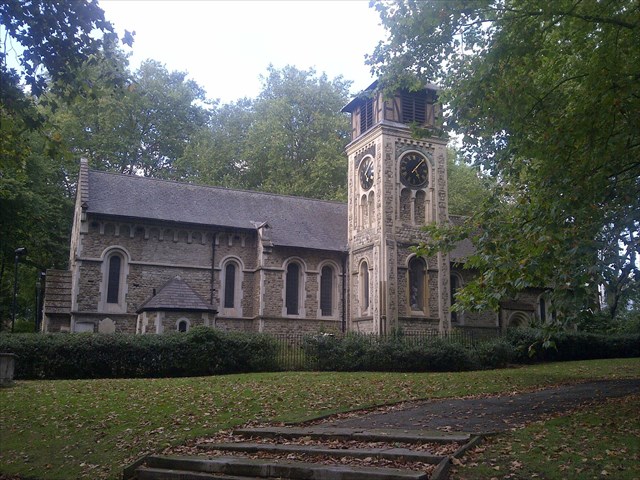Access
The site is about 700m north of the two railway stations. Follow Midland Road north on the west side of St Pancras and you will find the church on your right. Alternatively walk north up Pancras Road between Kings Cross and St Pancras stations and continue up Camley Street, under the Midland mainline and you will find a footpath into Pancras Gardens on your left. The gardens are open from 7am to dusk.
The church
The small church was rescued from dereliction in Victorian times, and has a long history. Legend has it that the first church here dated to AD314. There are fragments of Roman material in the building’s walls. Mention in the Domesday Book suggests a church was here before the Norman invasion. Some of the church’s remaining architectural features are Norman in origin, although obscured by later restoration. In the grounds is the ‘Hardy Tree’. When the Midland mainline was constructed through the church yard many graves had to be moved, and their headstones were arranged around a tree under the direction of the novelist and poet Thomas Hardy, who was an architectural surveyor at the time.

The headstones
The graveyard contains the burials of several well-known people, including:
- Sir John Soane, architect of the Bank of England and Dulwich Picture Gallery. His impressive tomb is worth a look.
- JC Bach, composer, buried in a pauper’s grave in 1782.
- John Flaxman, sculptor.
- Mary Wollstonecraft, writer and philosopher (there is a memorial, but her remains have been removed elsewhere)
Many of the names of headstones lost due to railway expansion and clearance to create the park, can be found on the impressive Burdett Coutts Memorial dating from 1877.
Weathering
Rich or poor, young or old, your headstone once erected will begin to weather. Weathering is the in situ breakdown of rocks into smaller fragments and new chemical compounds. It differs from erosion in that no movement (due to wind, water or ice) is involved. There are three types of weathering:
- Mechanical – a physical force breaks down rocks into smaller fragments. Freeze-thaw action (frost shattering) is the most well-known type where expanding ice forces cracks to open splitting rocks apart. The growth of salt crystals in cracks in coastal rocks works in a similar way.
- Chemical – rocks are attacked by acids and dissolved by solution weathering; rainfall is weak carbonic acid although the acidity of rainfall (and its potential as a weathering agent) can be dramatically increased by pollution. Iron compounds weather by oxidation, and the mineral feldspar found in granite weathers by hydrolysis to produce clay minerals.
- Biological – plants and tree roots can split rocks apart, and acids released by algae and lichens growing on rocks can also cause weathering.
Generally, sedimentary rocks (sandstone, limestone) weather more quickly than igneous rocks (granite, basalt) or metamorphic rocks (marble, slate).
The questions
To log this earthcache, please answer the following questions and email or message us the answers. You can log without waiting for a reply, we will contact you if there is a problem. We will endeavour the reply to each email / message.
Waypoint 1: Go to the Burdett Coutts memorial. Find a pair of headstones to Ann & William Birch (left) and Robert Purchese (right) against the green fence.
1a: Which headstone is more heavily weathered?
1b: Suggest a reason for the difference in degree of weathering.
Waypoint 2: Find the headstone of “the beloved daughter of William and Mary Jones”.
2a: Examine the very bottom of the headstone, and estimate how deeply weathered it is compared to the relatively unweathered surface with the inscription on. Measure in mm, or any other suitable unit.
2b: Why do you think the base of the headstone is more weathered than the upper part?
Waypoint 3: In this location, south of the church, are a number of rectangular tombs which are mostly made from white limestone. The Rhodes tomb is an exception, it is red granite.
3a: Describe the effect of weathering on the limestone surface and inscriptions.
3b: What type of weathering do you think has affected the limestone tombs, and why might this be worse in a city like London, compared to the countryside?
4 If you wish to (optional task), take a photo of you / your GPSr at the church or one of the headstones. No spoiler photos please.
We hope you enjoy visiting this fascinating little corner of London.